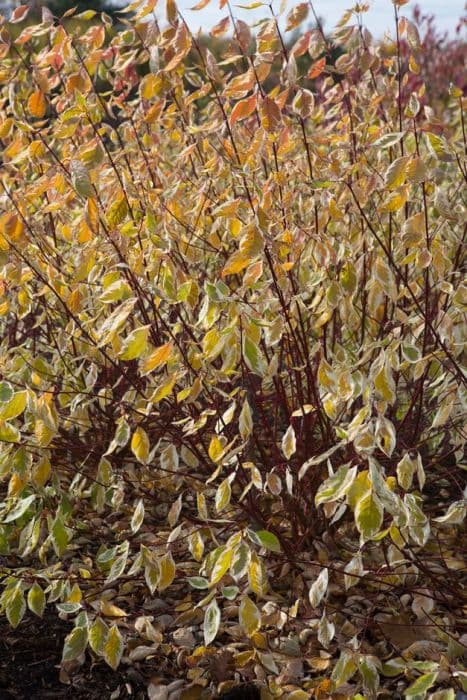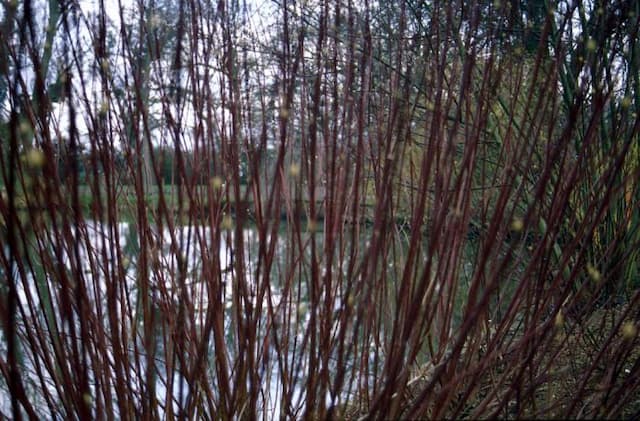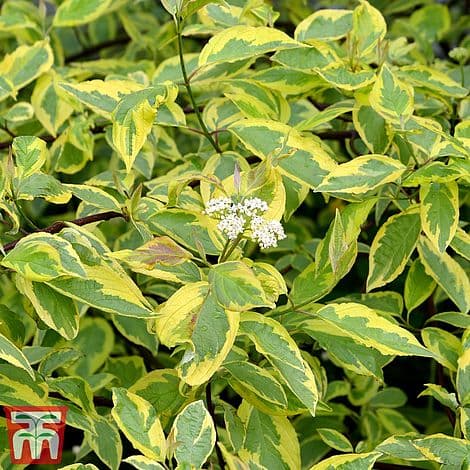Japanese Cornel Dogwood Cornus officinalis 'Kintoki'

ABOUT
Cornus officinalis 'Kintoki', commonly known as Japanese cornel or cornelian cherry, is a deciduous shrub renowned for its striking early spring flowers and colorful fruits. Before the leaves unfurl, this plant is adorned with a profusion of small, bright yellow blossoms that are tightly clustered along the bare branches, creating a vibrant show that heralds the end of winter. As the season progresses, these blossoms give way to oval shaped drupes, which are berries that start out green and gradually ripen to a glossy, cherry-red hue, providing a striking contrast against the lush green leaves. The leaves of the Japanese cornel are opposite, simple, and oval to oblong in shape with noticeable veining and a smooth margin. They boast a bright green color and can turn to shades of reddish-purple, adding autumnal interest. This shrub has an attractive bark that exfoliates in patches to reveal a mosaic of tan, brown, and gray, adding textural and visual appeal to the winter landscape when the branches are bare. 'Kintoki' is particularly valued for its ornamental characteristics, including the vibrant fruit which is not only visually appealing but also attracts birds and wildlife to the garden. The plant's multi-season interest makes it a favored choice for gardens that aim to offer color and life throughout the year.
About this plant
 Names
NamesSynonyms
Japanese Cornel Dogwood, Kintoki Cornel Dogwood, Asian Dogwood
Common names
Swida officinalis (Siebold & Zucc.) Soják, Benthamia kintoki (Miq.) Nakai, Cornus kintoki Miq.
 Toxicity
ToxicityTo humans
The Japanese Cornel Cherry, Cornus officinalis 'Kintoki', is not typically recognized as a poisonous plant to humans. However, like many plants, individual reactions can vary, and parts of the plant may be considered inedible. Some people might experience mild stomach upset if plant parts are ingested without proper preparation or in large quantities. In traditional medicine, parts of the plant may be used for health benefits, but it is crucial to use such remedies under professional guidance to avoid potential adverse effects.
To pets
The Japanese Cornel Cherry, Cornus officinalis 'Kintoki', is not commonly listed as toxic to pets. Pets that ingest parts of this plant might experience mild gastrointestinal discomfort, such as vomiting or diarrhea, especially if they consume a large amount of the plant material. However, most pets do not normally chew on this plant, and cases of poisoning are relatively rare. If you suspect your pet has ingested a significant amount of this plant and is showing adverse symptoms, it is best to consult with a veterinarian.
 Characteristics
CharacteristicsLife cycle
Perennials
Foliage type
Deciduous
Color of leaves
Green
Flower color
Yellow
Height
15-20 feet (4.5-6 meters)
Spread
15-20 feet (4.5-6 meters)
Plant type
Shrub
Hardiness zones
5
Native area
Asia
Benefits
 General Benefits
General Benefits- Aesthetic Appeal: The Cornelian cherry 'Kintoki' is known for its bright yellow flowers that bloom in early spring, providing a colorful display in the landscape.
- Attracts Wildlife: It produces edible red fruits that attract birds and other wildlife to the garden, enhancing biodiversity.
- Drought Tolerance: Once established, it has good drought resistance, making it suitable for gardens in drier climates.
- Low Maintenance: This cultivar requires minimal care once it's established, making it a convenient choice for gardeners seeking a low-maintenance plant.
- Seasonal Interest: The 'Kintoki' has ornamental bark that exfoliates with age, adding winter interest to the garden.
- Compact Size: Its relatively small size, compared to some trees, means it can fit into smaller gardens without overwhelming the space.
- Soil Versatility: It adapts well to various soil conditions, though it prefers well-drained, fertile soil.
 Medical Properties
Medical Properties- Anti-inflammatory effects: May help reduce inflammation in the body.
- Antioxidant properties: Contains compounds that can neutralize free radicals and reduce oxidative stress.
- Hepatoprotective activity: Might support and protect liver health.
- Antimicrobial activity: May have properties that inhibit the growth of bacteria, viruses, or fungi.
- Cardiovascular support: Could potentially improve heart health by affecting vascular functions.
- Immunomodulatory effects: Might influence the immune system to promote a balanced immune response.
 Air-purifying Qualities
Air-purifying QualitiesThis plant is not specifically known for air purifying qualities.
 Other Uses
Other Uses- Cornelian cherry 'Kintoki' bark can be used to create dyes for fabrics, yielding colors such as warm yellows and golden hues.
- The hard and dense wood of Cornelian cherry 'Kintoki' can be utilized in woodcraft for making small items such as tool handles, engraving blocks, and turned objects.
- The fruit of Cornelian cherry 'Kintoki' can be processed into tart and flavorful jams, jellies, and syrups, which can be used in culinary preparations or as spreads.
- Cornelian cherry 'Kintoki' fruits are fermented to make wine and spirits in some traditional Eastern European and Southwest Asian cultures.
- The wood of Cornelian cherry 'Kintoki' is sometimes used for smoking foods to impart a unique flavor, similar to how hickory or mesquite wood is used.
- In some regions, the leaves of Cornelian cherry 'Kintoki' are used in the tanning industry to treat leather, thanks to their tannin content.
- Fresh fruit from the Cornelian cherry 'Kintoki' can be consumed as a sour snack, often salted or paired with chili mixtures in some cultures.
- The bright yellow flowers of the Cornelian cherry 'Kintoki' can be floated in bowls of water to create simple, natural decorative elements for festivals and celebrations.
- In landscape design, Cornelian cherry 'Kintoki' is planted to attract pollinators like bees and butterflies, bolstering the ecosystem's health.
- The foliage of the Cornelian cherry 'Kintoki' displays striking autumn colors, making it useful in ornamental planting for seasonal garden interest.
Interesting Facts
 Feng Shui
Feng ShuiThe Cornelian Cherry is not used in Feng Shui practice.
 Zodiac Sign Compitability
Zodiac Sign CompitabilityThe Cornelian Cherry is not used in astrology practice.
 Plant Symbolism
Plant Symbolism- Longevity and Prosperity: Cornus officinalis, commonly known as Japanese Cornel Dogwood, often symbolizes longevity and prosperity due to its medicinal properties and its long-lasting nature.
- Strength and Resilience: The wood of the Japanese Cornel Dogwood is hard and durable, making it represent strength and resilience.
- Protection: In some cultures, the plant is believed to have protective qualities, warding off evil spirits and negativity.
- Renewal and Hope: The early spring blossoms of the 'Kintoki' variety signify renewal and hope as they are among the first to bloom, signaling the end of winter and the promise of spring.
 Water
WaterJapanese Cornel Dogwood requires consistent moisture, particularly during dry spells. Water the plant deeply once a week with approximately 1-2 gallons of water, depending on the size of the plant and the weather conditions. Adjust the amount of water during periods of heavy rain or drought, always checking the soil moisture; it should be moist but not soggy. In hot summer months, you might need to water twice a week, especially if the plant is in well-drained soil or a hot location.
 Light
LightJapanese Cornel Dogwood thrives in full sun to partial shade. The ideal spot would receive morning sunlight and afternoon shade, or dappled sunlight throughout the day. Avoid deep shade as it may hinder flowering and fruiting, as well as sun-scorched spots which might damage the leaves during the hottest part of the summer.
 Temperature
TemperatureJapanese Cornel Dogwood is quite adaptable and can tolerate temperatures as low as 0°F but prefers a range between 60°F and 75°F for optimal growth. The plant can withstand brief periods of hotter temperatures, but prolonged heat above 86°F may stress the dogwood.
 Pruning
PruningPrune the Japanese Cornel Dogwood to maintain its shape and remove dead or diseased wood. The best time for pruning is late winter or early spring before new growth starts. Light pruning can be done annually; however, more significant shaping should occur every two to three years to ensure the health and aesthetics of the tree.
 Cleaning
CleaningAs needed
 Soil
SoilJapanese Cornel Cherry (Cornus officinalis 'Kintoki') prefers well-draining soil that is rich in organic matter. The ideal soil mix can consist of equal parts loamy garden soil, peat moss, and perlite to ensure good drainage and aeration. The soil pH should be mildly acidic to neutral, ranging from 5.5 to 7.0 for optimal growth.
 Repotting
RepottingThe Japanese Cornel Cherry should be repotted every two to three years to refresh the soil and promote healthy growth. Timing for repotting is ideally in the late winter or early spring before new growth begins.
 Humidity & Misting
Humidity & MistingJapanese Cornel Cherry thrives in moderate humidity levels similar to that of its natural woodland habitat. While it does not require tropical levels of humidity, it benefits from a consistent environment without extreme dryness.
 Suitable locations
Suitable locationsIndoor
Provide bright light, consistent moisture, and good air circulation.
Outdoor
Plant in part-shade, protect from harsh winds, ensure moist soil.
Hardiness zone
5-8 USDA.
 Life cycle
Life cycleCornus officinalis 'Kintoki', commonly known as Japanese cornelian cherry, begins its life cycle as a seed, which after stratification to overcome dormancy, germinates in the spring. Once the seedling emerges, it establishes a primary root system and develops its first set of true leaves, slowly growing into a young plant. As a perennial, the young plant will gradually mature over several years, developing a robust root system and woody stems. The mature shrub produces clusters of small yellow flowers in late winter to early spring before the leaves appear, which are then followed by the formation of small, red, cherry-like fruits that mature by late summer. These fruits are then dispersed by animals or gravity, with the potential to become new seeds that restart the cycle. Throughout its life, Japanese cornelian cherry will go through multiple seasons of growth and dormancy, with pruning and care enhancing its health and longevity.
 Propogation
PropogationPropogation time
Spring to early summer
Propogation: The most popular method of propagating Cornelian cherry 'Kintoki' is through seeds. To propagate by seeds, collect them in the fall after the fruit fully ripens and clean off the flesh. The seeds have a hard outer coating, so they require stratification before planting. This process involves exposing the seeds to cold, moist conditions for several months to break down the seed coat and encourage germination. Typically, seeds are mixed with moist sand and placed in a plastic bag, which is then stored in a refrigerator for about 90 to 120 days. After cold stratification, plant the seeds about half an inch deep (approximately 1.27 cm) in a well-draining soil mix and keep them in a location with indirect sunlight until they germinate, which can take several weeks.









